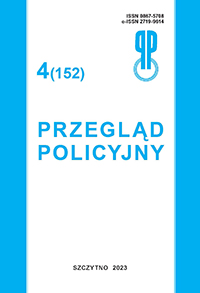Prace badawcze dotyczące wyznaczania stref bezpieczeństwa opracowanych na podstawie badań eksperymentalnych
Research Work on the Determination of Safety Zones Based on Experimental Studies
Author(s): Izabela Mazur, Piotr Kasprzak, Wawrzyniec PniewskiSubject(s): Security and defense, Military policy, Peace and Conflict Studies
Published by: Akademia Policji w Szczytnie
Keywords: security threat; IED; improvised explosive device safety; data collection; post-blast investigation; fragment impact; CBRNE threat;
Summary/Abstract: The end of the last century and the beginning of the 21st indicate that we are living in an era where armed conflicts threaten civilians in various parts of the world. Very often, they are used to achieve their goals by armed or terrorist groups and organisations. The article takes a closer look at the phenomenon of terrorism using improvised explosive devices prepared from components available to the group. It is worth recalling that the design and manufacture of an explosive device depend only on the technical capabilities, knowledge and ingenuity of the bomber. It is not insignificant that the resulting explosive effect is often reinforced by additives (nails, screws, broken glass, metal rods, glass and metal balls), or the addition of other strongly fragmenting structural components. An equally common solution for reinforcing a prepared improvised explosive device is the use of, for example, insecticides, pepper gas or chemical industrial wastes, which influence the potential victim through perceptible effects (burning and watery eyes, pain in the lungs when breathing, irritating odour) to be convinced of an attack with chemical warfare (CW) agents. The final threat is the possibility of the use of actual agents of weapons of mass destruction, i.e.: chemical, biological, radiological. Taking into account all the information on the components of improvised explosive devices, it has become very important to assess the impact and estimate the effects of the explosion. This is a complex process that depends on many factors and variables. The article describes how difficult it is to interpret the impact on the environment of an explosion of this type of charge, what the scattering of shrapnel or its targeting might be, and presents possible systems to support the work of those involved in the fight against terrorism in the process of data collection from the detection of the charge through the investigation/explosive investigation to the analysis of data obtained in the explosive investigation (chemical analysis of gases and residues, recovery of generated shrapnel)
Journal: Przegląd Policyjny
- Issue Year: 152/2023
- Issue No: 4
- Page Range: 5-21
- Page Count: 17
- Language: Polish

